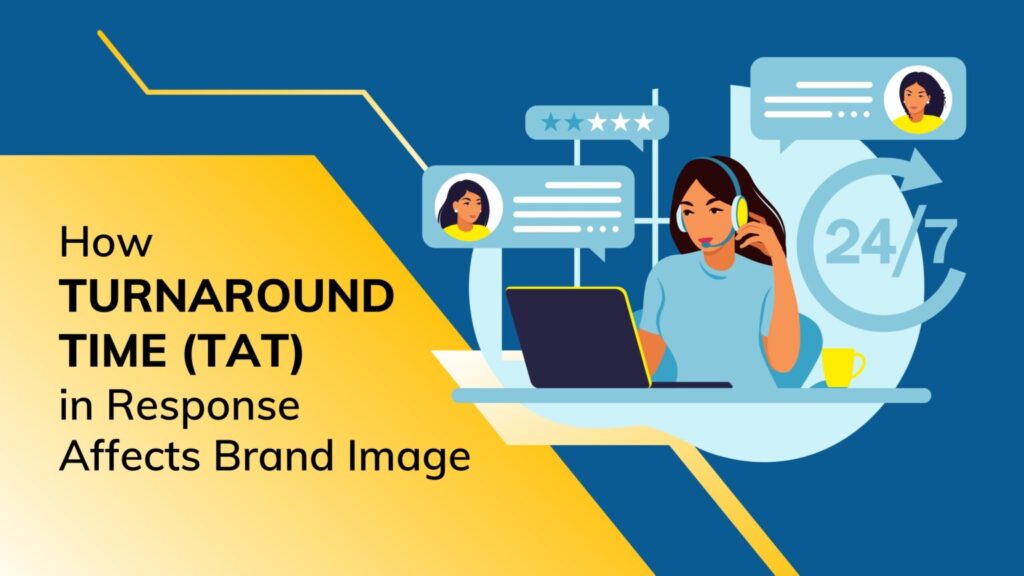When it comes to building brand image, brands have to go all out—especially when it comes to responding to their customers. In today’s fast-paced world, customers are used to getting responses to queries within a matter of minutes, or even seconds. So when a brand makes a customer wait or delays the response time, it can lose out on the customer.
A faster turnaround time is directly proportional to maintaining a good brand image, and managing brand reputation in today’s world is everything. A better image means more customers and more loyalty and trust in the market.
Let’s find out more.
 Failure on the part of a brand to respond on time or take too long to answer a customer’s query can lead to the brand losing the customer. A higher TAT could push the customer to switch brands. The lack of a timely solution could mean lower social media engagement for the brand and cause reputational damage. A higher TAT could lead to customers getting angry or frustrated, leading to poor reviews and testimonials and, in turn, resulting in lower sales or revenue generation.
TAT is an integral part of any brand’s image. For example, a brand on social media that sells cosmetics and has a higher or faster TAT to its customers will do better than one that takes a lot of time to respond to its customers. This holds for well-known brands as well. Irrespective of how big the brand may be or how many customers it might have around the world, the minute a brand falters on its customer turnaround time, it is likely to lose out on customers.
Failure on the part of a brand to respond on time or take too long to answer a customer’s query can lead to the brand losing the customer. A higher TAT could push the customer to switch brands. The lack of a timely solution could mean lower social media engagement for the brand and cause reputational damage. A higher TAT could lead to customers getting angry or frustrated, leading to poor reviews and testimonials and, in turn, resulting in lower sales or revenue generation.
TAT is an integral part of any brand’s image. For example, a brand on social media that sells cosmetics and has a higher or faster TAT to its customers will do better than one that takes a lot of time to respond to its customers. This holds for well-known brands as well. Irrespective of how big the brand may be or how many customers it might have around the world, the minute a brand falters on its customer turnaround time, it is likely to lose out on customers.

Introduction
Turnaround time, or TAT, refers to the time taken by a business or brand to respond to a customer. Timely responses to customers, be it in terms of addressing queries about product delivery or after-sales service, contribute positively towards building customer loyalty. A short TAT is vital in the digital-first world, where customers expect responses immediately and will move on to a competitor brand if their queries are not resolved. The query is closed only when the customer is satisfied with the response provided and their problem has been resolved. Every industry has a different TAT for responses. For example, the response time for a quick-service restaurant or an e-commerce company would be a lot faster than the TAT for a financial services company or an educational institution. Increasingly, customers are reaching out to brands with queries and requests, with the expectation that they will get a resolution as soon as possible. So then, what happens when the brand fails to meet this expectation? A poor TAT can lead a brand to lose customers, and its reputation could be tarnished. Brands depend on customers and market reputation to build a long-term space for themselves. They depend on their image for revenue generation and business valuation. So a poor turnaround time can have severe effects on a brand’s image.Importance of low TAT for a brand
Responding to customers promptly is key to making the customer feel valued. A lower or faster TAT goes a long way in building brand image. Better TAT directly amounts to greater predictability; this means that the customer has a better understanding of how soon the brand is going to answer a query and remains loyal to the brand based on this predictability. A better TAT also allows the product to reach the customer faster; instead of the customer waiting around or going to a competitor, better service will help retain customers. Further, a faster TAT also gives brands a better chance of identifying bottlenecks in the product life cycle. For example, only when a brand is focused on responding to customer queries can it understand what a customer’s needs and problems are and then use its products or services to address these pain points. More than 30% of customers expect brands to respond to their online DMs within an hour, while more than 70% expect a brand to respond no later than 24 hours. The biggest expectation that a customer generally has from a brand is an open channel of communication where the brand responds to queries in an agile and quick manner. Customers expect brands to have resolutions ready and interact with them, irrespective of what the query may be. Failure on the part of a brand to respond on time or take too long to answer a customer’s query can lead to the brand losing the customer. A higher TAT could push the customer to switch brands. The lack of a timely solution could mean lower social media engagement for the brand and cause reputational damage. A higher TAT could lead to customers getting angry or frustrated, leading to poor reviews and testimonials and, in turn, resulting in lower sales or revenue generation.
TAT is an integral part of any brand’s image. For example, a brand on social media that sells cosmetics and has a higher or faster TAT to its customers will do better than one that takes a lot of time to respond to its customers. This holds for well-known brands as well. Irrespective of how big the brand may be or how many customers it might have around the world, the minute a brand falters on its customer turnaround time, it is likely to lose out on customers.
Failure on the part of a brand to respond on time or take too long to answer a customer’s query can lead to the brand losing the customer. A higher TAT could push the customer to switch brands. The lack of a timely solution could mean lower social media engagement for the brand and cause reputational damage. A higher TAT could lead to customers getting angry or frustrated, leading to poor reviews and testimonials and, in turn, resulting in lower sales or revenue generation.
TAT is an integral part of any brand’s image. For example, a brand on social media that sells cosmetics and has a higher or faster TAT to its customers will do better than one that takes a lot of time to respond to its customers. This holds for well-known brands as well. Irrespective of how big the brand may be or how many customers it might have around the world, the minute a brand falters on its customer turnaround time, it is likely to lose out on customers.
Benefits of low TAT
There are many ways in which a quicker response time or a low TAT benefits a brand. Strengthening Brand Loyalty: One of the key aspects of building a brand is ensuring brand loyalty. Companies hire reputational managers to build a strong online and offline presence and to listen to their prospective and existing customers. Listening to customer feedback and understanding the problems can help a brand improve its product or service, thereby resulting in stronger deliverables and better customer loyalty. Customers are more likely to be loyal to a brand that understands their needs. Community Building: A quicker response time allows customers to feel more in tune with the brand. It establishes that the brand is listening to their needs and grievances and is interested in improving their personal experiences. Customers develop a sense of belonging and affinity toward the brand. This then helps brands build a community of followers. Set Expectations: If a brand typically responds to customers’ DMs within three hours, customers have a reasonable expectation of how long they must wait before they receive a response. Many brands usually put a disclaimer on their website and social media platforms, so customers have an idea of when to expect a response and are not waiting endlessly. Increase customer satisfaction: A lower TAT means higher customer satisfaction. Customers are more likely to purchase products and services from a brand that responds to them immediately as opposed to one that doesn’t. Frequent response delays or an unpredictable and long TAT can result in revenue loss and customer loss. When a brand responds to a customer’s query, the customer feels like their pain points have been heard and addressed, which helps foster more faith in the brand. Brands should avoid not dealing with or confronting displeasure faced by customers, because, ultimately, the customer is king.
How can a brand improve its response to TAT?
How is a brand that has thousands of customers from around the world expected to respond to customer queries promptly? It has become easier and faster for brands to communicate with customers using digital tools.- Chatbots: While companies continue to employ customer service representatives to solve queries, the integration of chatbots and AI has become rampant, especially in addressing standard issues and problems.
- Social Listening: Brands are adopting listening and interaction tools as part of their engagement strategy to better connect with customers. These tools allow brands to listen in on their customers, understand their search-related queries, and pre-empt the challenges they are facing. Based on this understanding, brands can respond to customers faster.
- Prioritizing Requests: Companies with robust customer service departments in place, prioritize customer requests to answer them quickly and effectively. While answering every customer query is critical, a brand must have some flexibility to categorize the requests based on urgency and answer those that need special attention at the earliest.
- FAQs: A simple yet effective idea is to set up an FAQ page and list the most commonly asked questions and answers to problems customers face. These could be about product deliveries, payments, or the product/service itself. Brands can come up with FAQs based on past customer interactions and share appropriate responses. This helps in reducing the TAT considerably, as customers can immediately be redirected to the FAQs page to get the response they need, rather than wait for a point of contact from the brand to revert.


